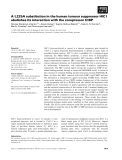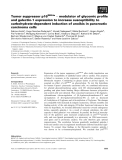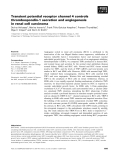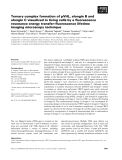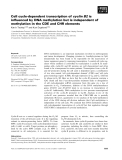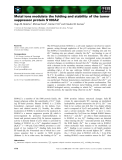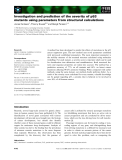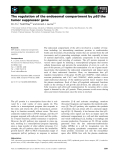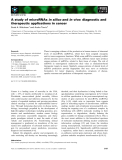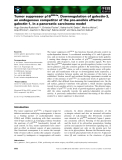
Tumor suppressor
-
Regulator of G protein signaling (RGS) proteins are gatekeepers regulating the cellular responses induced by G protein-coupled receptor (GPCR)-mediated activation of heterotrimeric G proteins. Specifically, RGS proteins determine the magnitude and duration of GPCR signaling by acting as a GTPase-activating protein for Gα subunits, an activity facilitated by their semiconserved RGS domain. The R7 subfamily of RGS proteins is distinguished by two unique domains, DEP/DHEX and GGL, which mediate membrane targeting and stability of these proteins.
 13p
13p  caothientrangnguyen
caothientrangnguyen
 09-05-2020
09-05-2020
 30
30
 1
1
 Download
Download
-
Amplification of N-myc oncogene is a frequent event in advanced stages of human neuroblastoma and correlates with poor prognosis and enhanced neovascularization. Angiogenesis is an indispensable prerequisite for the progression and metastasis of solid malignancies, which is modulated by tumor suppressors and oncogenes. We have addressed the possibility that N-myc oncogene might regulate angiogenesis in neuroblastoma. Here, we report that experimental N-Myc overexpression results in down-regulation of leukemia inhibitory factor (LIF), a modulator of endothelial cell proliferation....
 10p
10p  system191
system191
 01-06-2013
01-06-2013
 36
36
 4
4
 Download
Download
-
Erythropoietin (Epo) is a hematopoietic cytokine that is crucial for the differentiation and proliferation of erythroid progenitor cells. Epo acts on its target cells by inducing homodimerization of the erythropoietin receptor (EpoR), thereby triggering intracellular signaling cascades. The EpoR encompasses eight tyrosine motifs on its cytoplasmic tail that have been shown to recruit a number of regulatory proteins.
 11p
11p  research12
research12
 29-04-2013
29-04-2013
 35
35
 3
3
 Download
Download
-
The tumor suppressor protein, p53, selectively binds to supercoiled (sc) DNA lacking the specific p53 consensus binding sequence (p53CON). Using p53 deletion mutants, we have previously shown that the p53 C-terminal DNA-binding site (CTDBS) is critical for this binding.
 12p
12p  awards
awards
 05-04-2013
05-04-2013
 47
47
 5
5
 Download
Download
-
HIC1(hypermethylated in cancer 1) is a transcriptional repressor containing fiveKru¨ppel-likeC2H2zinc fingers and an N-terminal dimerization and autonomous repression domain called BTB/POZ. Here, we demonstrate that full-length HIC1 proteins are modified both in vivo andin vitro with O-linkedN-acetylglucosamine (O-GlcNAc). This is a highly dynamic glycosylation found within the cytosolic and the nuclear compartments of eukaryotes. Analysis of [ 3 H]Gal-labeled tryptic peptides indicates that HIC1 has three major sites forO-GlcNAc glycosylation....
 12p
12p  awards
awards
 05-04-2013
05-04-2013
 55
55
 4
4
 Download
Download
-
RNA helicase A (RHA), a member of DNA and RNA helicase family containing ATPase activity, is involved in many steps of gene expression such as transcription and mRNA export. RHA has been reported to bind directly to the transcriptional coactivator, CREB-binding protein, and the tumor suppressor protein, BRCA1, and links them to RNAPolymerase II holoenzyme complex. Using yeast two-hybrid screening, we have identified RHA as an interacting molecule of the p65 subunit of nuclear factorjB(NF-jB).
 11p
11p  awards
awards
 05-04-2013
05-04-2013
 32
32
 4
4
 Download
Download
-
trans-[PtCl2NH3(4-Hydroxymethylpyridine)] (trans-PtHMP) is an analogue of clinically ineffective transplatin, which is cytotoxic in the human leuke-mia cancer cell line. As DNA is a major pharmacological target of anti-tumor platinum compounds, modifications of DNA by trans-PtHMP and recognition of these modifications by active tumor suppressor protein p53 were studied in cell-free media using the methods of molecular biology and biophysics.
 14p
14p  dell39
dell39
 27-03-2013
27-03-2013
 50
50
 4
4
 Download
Download
-
HIC1(hypermethylated in cancer) is a tumour suppressor gene located in 17p13.3, a region frequently hypermethylated or deleted in many types of prevalent human tumour.HIC1is also a candidate for a contiguous-gene syndrome, the Miller–Dieker syndrome, a severe form of lissencephaly accompanied by developmental anomalies.
 12p
12p  inspiron33
inspiron33
 25-03-2013
25-03-2013
 36
36
 3
3
 Download
Download
-
Expression of the tumor suppressor p16 INK4a after stable transfection can restore the susceptibility of epithelial tumor cells to anoikis. This property is linked to increases in the expression and cell-surface presence of the fibronectin receptor. Considering its glycan chains as pivotal signals, we assumed an effect of p16 INK4a on glycosylation.
 24p
24p  galaxyss3
galaxyss3
 19-03-2013
19-03-2013
 33
33
 5
5
 Download
Download
-
Angiogenic switch in renal cell carcinoma (RCC) is attributed to the inactivation of the von Hippel–Lindau tumor suppressor, stabilization of hypoxia inducible factor-1 transcription factor and increased vascular endothelial growth factor.
 13p
13p  media19
media19
 05-03-2013
05-03-2013
 29
29
 2
2
 Download
Download
-
The tumor suppressor von Hippel–Lindau (VHL) gene product forms a com-plex with elongin B and elongin C, and acts as a recognition subunit of a ubiquitin E3 ligase. Interactions between components in the complex were investigated in living cells by fluorescence resonance energy transfer (FRET)–fluorescence lifetime imaging microscopy (FLIM).
 9p
9p  media19
media19
 04-03-2013
04-03-2013
 45
45
 2
2
 Download
Download
-
DNA methylation is an important mechanism involved in embryogenesis and tumor development. Changing cytosines to 5-methylcytosines in CpG dinucleotides has been found to be responsible for the inactivation of tumor suppressor genes by repressing transcription.
 15p
15p  media19
media19
 04-03-2013
04-03-2013
 37
37
 2
2
 Download
Download
-
The EF-hand protein S100A2 is a cell cycle regulator involved in tumori-genesis, acting through regulation of the p53 activation state. Metal ion-free S100A2 is homodimeric and contains two Ca 2+ -binding sites and two Zn 2+ -binding sites per subunit, whereby the Zn 2+ ion binding to one of the sites is coordinated by residues from two homodimers.
 11p
11p  vinaphone15
vinaphone15
 27-02-2013
27-02-2013
 37
37
 2
2
 Download
Download
-
A method has been developed to predict the effects of mutations in the p53 cancer suppressor gene. The new method uses novel parameters combined with previously established parameters. The most important parameter is the stability measure of the mutated structure calculated using molecular modelling.
 14p
14p  vinaphone15
vinaphone15
 25-02-2013
25-02-2013
 39
39
 2
2
 Download
Download
-
The endosomal compartment of the cell is involved in a number of func-tions including: (a) internalizing membrane proteins to multivesicular bodies and lysosomes; (b) producing vesicles that are secreted from the cell (exosomes); and (c) generating autophagic vesicles that, especially in times of nutrient deprivation, supply cytoplasmic components to the lysosome for degradation and recycling of nutrients.
 12p
12p  viettel02
viettel02
 22-02-2013
22-02-2013
 33
33
 3
3
 Download
Download
-
There is emerging evidence of the production in human tumors of abnormal levels of microRNAs (miRNAs), which have been assigned oncogenic and⁄or tumor-suppressor functions. While some miRNAs commonly exhibit altered amounts across tumors, more often, different tumor types produce unique patterns of miRNAs, related to their tissue of origin.
 8p
8p  viettel02
viettel02
 22-02-2013
22-02-2013
 44
44
 3
3
 Download
Download
-
The tumor suppressor p16 INK4a has functions beyond cell-cycle control via cyclin-dependent kinases. A coordinated remodeling ofN- and O-glycosyla-tion, and an increase in the presentation of the endogenous lectin galectin-1 sensing these changes on the surface of p16 INK4a -expressing pancreatic carcinoma cells (Capan-1), lead to potent pro-anoikis signals.
 12p
12p  viettel02
viettel02
 19-02-2013
19-02-2013
 58
58
 4
4
 Download
Download
-
Mutations in the tumor suppressor breast cancer susceptibility gene 1 (BRCA1), an important player in the DNA damage response, apoptosis, cell cycle regulation and transcription, confer a significantly elevated life-time risk for breast and ovarian cancer.
 11p
11p  viettel02
viettel02
 19-02-2013
19-02-2013
 51
51
 2
2
 Download
Download
-
Over the past several years, the importance of regulated nuclear transport processes for tumor suppressors has become evident. Proteins with a molecular mass greater than 40 kDa can enter the nucleus only by active transport across the nuclear membrane. The most common pathway by which this occurs is via the importin alpha⁄beta pathway, whereby the cargo protein binds importin alpha.
 7p
7p  viettel02
viettel02
 19-02-2013
19-02-2013
 41
41
 3
3
 Download
Download
-
he tumor suppressor, breast cancer susceptibility gene 1 (BRCA1), plays an integral role in the maintenance of genome stability and, in particular, the cellular response to DNA damage. Here, the emerging role of BRCA1 in nonhomologous end-joining-mediated DNA repair following DNA dam-age will be reviewed, as well as the activation of apoptotic pathways.
 7p
7p  viettel02
viettel02
 19-02-2013
19-02-2013
 49
49
 3
3
 Download
Download
CHỦ ĐỀ BẠN MUỐN TÌM













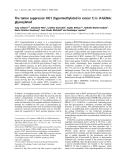

![Báo cáo khoa học: Recognition of DNA modified by trans-[PtCl2NH3(4hydroxymethylpyridine)] by tumor suppressor protein p53 and character of DNA adducts of this cytotoxic complex Báo cáo khoa học: Recognition of DNA modified by trans-[PtCl2NH3(4hydroxymethylpyridine)] by tumor suppressor protein p53 and character of DNA adducts of this cytotoxic complex](https://tailieu.vn/image/document/thumbnail/2013/20130327/dell39/135x160/9041364380424.jpg)
